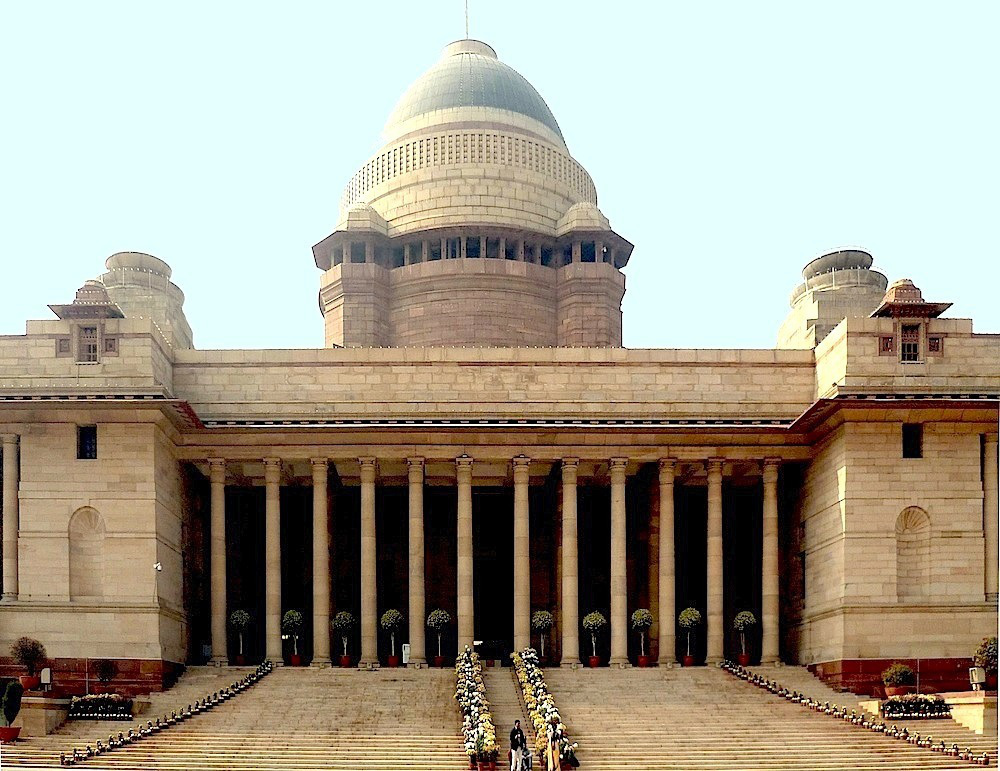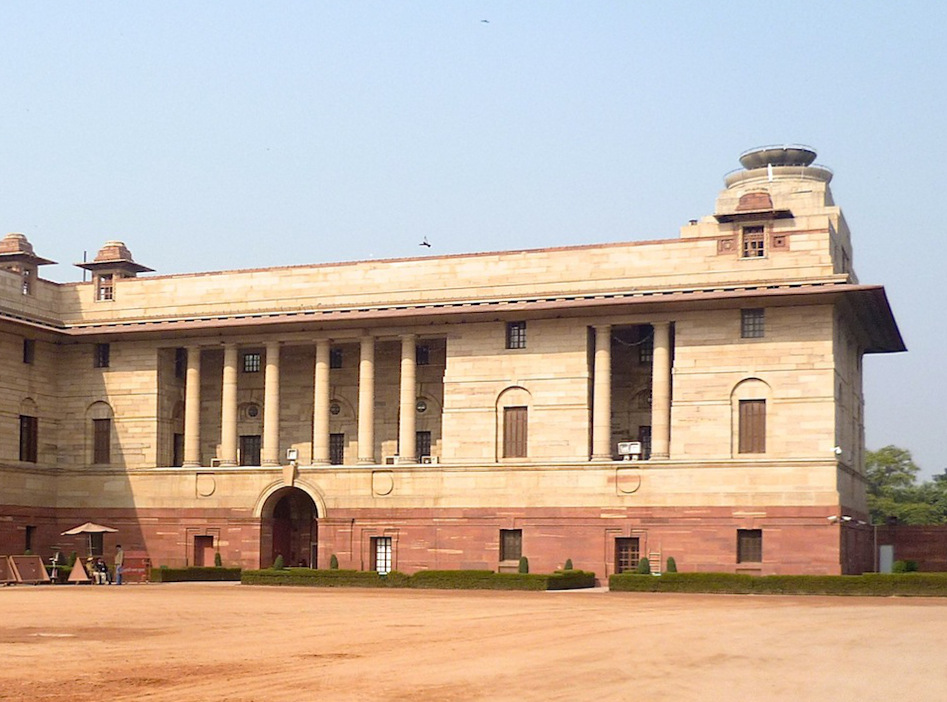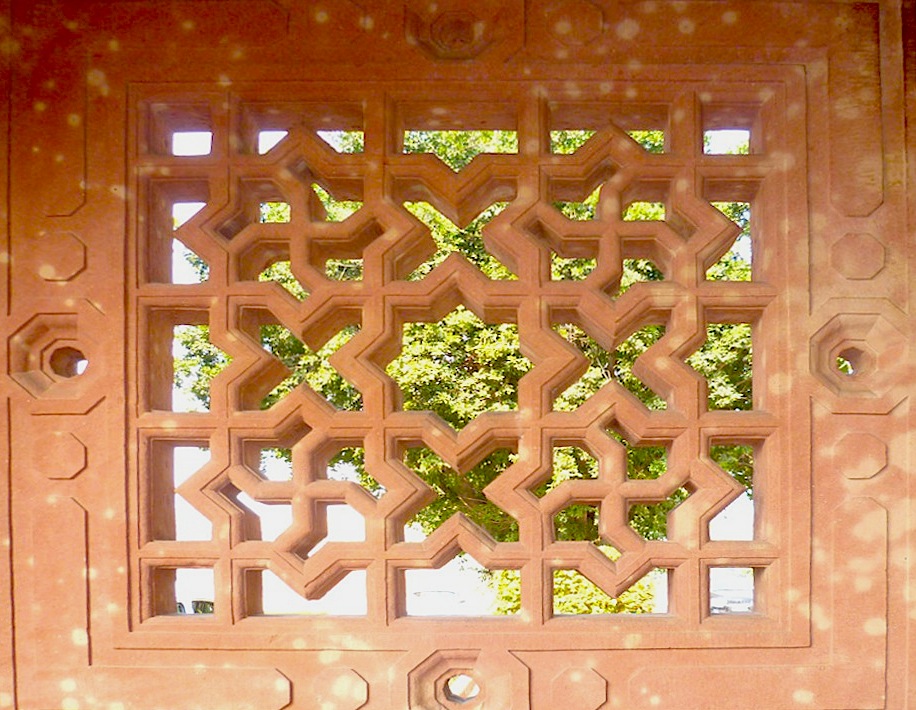Photographs by the present author, except where otherwise stated. [You may use these images without prior permission for any scholarly or educational purpose as long as you (1) credit the photographer and (2) link your document to this URL in a web document or cite the Victorian Web in a print one. Click on the thumbnails for larger images.]
Exterior

Viceroy's House, now Rashtrapati Bhavan (Hindi for "President's House"), Raisina Hill, New Delhi, India; three-quarter view of the main east front. 1921-27 (Ching et al. 709), but its architect Edwin Landseer Lutyens (1869-1944) began designing it in 1912 ("Chronology"), and the Viceroy and Lady Irwin finally moved in on 23 December 1929 ("New Delhi"). This is far outside our website's chronological remit, yet the Viceroy's House was in many ways the high point of Lutyens' brilliant career as an architect, and the fulfilment of the long quest for a synthesis of Western and Eastern architectural styles, both of which had developed during the Victorian period. Controversy arises largely over its expression of imperial resolve, and this too was a culmination of changes in attitude that had evolved during the previous century.

Painting in the vestibule of the Rashtrapati Bhavan, showing the whole main (east) front.
Certain points are beyond contention. By far the most important residence that Lutyens ever designed, this is also the grandest of all the residences that the British built in India, a fitting successor to the original grand colonial palace of the Raj, Charles Wyatt's Raj Bhavan in Kolkata. Described as "the largest of all modern palaces, 600 feet long from end to end, 180 feet to the top of its central dome," Lutyens' new headquarters for a brand new capital had 340 rooms, covered four and a half acres and included twelve separate internal courtyards, making it "probably the last of the great royal palaces of history" (Morris 77). Rising above the executive and legislative offices of the state, and overlooking the city itself, this made a clear statement of British imperial intentions.
The position of the site seems acceptable enough to some. One commentator writes, "whether accidentally or by design, Lutyens created the new capital in the exact shape of the traditional Vastu Purusha [the god of construction, whose supine form determines the best metaphysical plan of a building site], whose head is on Raisina Hill and whose feet rest at the Purana Quila [the oldest fort in Delhi]" (Buch 30). In fact, Lutyens' colleague Herbert Baker (1862-1946; later Sir Herbert Baker) explained later that the site was chosen after considerable deliberation, not precisely with this auspicious plan in mind, but taking into account the "road system based on two great roads" (Baker 776). However, to others the siting is "an act of imperial cartography" (Sharma 30), Raisina Hill being somewhat out on a limb, looking down from a height on, and separated from, the shambolic mass of the inhabitants of the older city.

Central Vista (Rajpath). This two-mile long Central Vista links the Viceroy's Palace to the Memorial Arch. Around it were constructed the official buildings as well as the residences of Princely Rulers from the different Indian States. Photograph and caption: Medha Malik Kudaisya. [Note the dome of the Rashtrapati Bhavan in the middle distance.]
In point of fact, Lutyens was upset to find that the steep rise towards it, between his colleague Sir Herbert Baker's Secretariat buildings, prevented it from being seen from a distance in almost any of its glory. Only the dome and its drum are visible from lower down the rise, something that Philip Davies considers "a conceptual error" (231). Lutyens' battle to put this right by excavating the hillside proved unavailing, and Davies ascribes the unsatisfactory result to a failure of collaboration between these two giants of contemporary architecture: Baker had been the greatest force in South African architecture for the twenty years preceding this collaboration. It could not have been an easy working partnership.
Questions also arise in connection with the building materials. The main ones are utterly appropriate in local terms: "the same red sandstone that the Moghuls had used at Fatehpur Sikr [the ancient fortified city close to Agra] interspersed with cream stone from Dholpur, Bharatpur and Agra, in brilliant horizontal bands of colour accentuating the horizontal emphasis of the whole edifice" (Davies 229). Yet the whole ensemble is read critically by some (not necessarily Indians) because the sandstone was reinforced by the fruits of British industry — iron, steel and concrete — and could thus be seen as "the utlimate ossification of the provisional 'scaffolding' with which the colonial polity had been assembled." Going further, the same critic infers: "What remained of the aborted project of colonial social engineering was only the hollow facade of imperial authority and system, propped up by the skeletal cage of its own technical superstructure" (Scriver 73).


Left: Closer view of the frontage, with ceremonial cannons, from the south. Right: Entrance portico at the top of the sweeping stone steps, with the central dome above.
However, the structure is "redeemed," as the current President's official website puts it, by its many Indian features. Lutyens professed no fondness at all for Indian touches on western architecture. Indeed, he disliked the idea of an "'orientalised' classicism"; but, after all, he had to reach a compromise on this (see Metcalf 234). He did so with remarkable success. The most important feature of all is the raised copper-clad central dome. Octagonal turrets encircle a pierced stone drum, which is capped with a vast hemispherical dome. This might look classical or even Byzantine, and Lutyens himself never admitted that it had an Indian source. But is widely accepted as having been modelled on the great third-century Buddhist Stupa at Sanchi in Madhya Pradesh, built by the Emperor Ashoka. The stupa was being restored under the British at just this time (1912-19). For Lutyens, suggests Thomas Metcalf, such a source "provided a way of evading the communal tangle of Hindu and Muslim" (An Imperial Vision, 238).


Left: Close view of the top of the colonnade. Right: The north-east wing, showing the intermittent colonnading that produces loggias.
Similarly, the capitals might look like Corinthian ones from a distance, but are carved with acanthus leaves and small hanging Indian bells, like temple bells, one at each corner: Davies calls this "the Delhi order" (228). Above the colonnade is the chuja, a deep cornice or projecting stone shade, as used by the Moghuls to protect against sun and the monsoon. This is attractively picked out in red, in an Indian design, on the visible underside. The north-east wing shows not only the loggias that shade the windows and doors, but, at the turning point (on the left side of the photograph), adjacent chattris or canopied structures on the roofline, a feature of Rajasthani architecture. On the roof at the end of the wing is another of the larger stone-basin fountains that enliven the roofline. According to the floor plan (see Morris 79), this wing was mainly for clerks, with other rooms marked out for the cashier, stationery etc. One of the least welcome British legacies to India was an addiction to red tape.

Perspective View of the South Elevation of the Viceroy's House (now known as Rashtrapati Bhavan), New Delhi, India." By Lutyens' and Baker's artist, the perspectivist William Walcot (1874-1943), 1914. Courtesy of the WolfsonianFIU (see bibliography).
Details



Left to right: (a) and (b) An arched passageway within the complex. Jan Morris writes of the "endless arched corridors" which "seemed to run through the house like sumptuous warrens" (81). (c) One of the jaalis, or pierced stone lattice screens (see Metcalf, An Imperial Vision, 284) that let in the air while providing shade from the sunlight, and shelter from rain.
Of Lutyens' earlier domestic architecture, Sir Lawrence Weaver (1876-1930), architectural editor of Country Life, wrote in 1921: "We come continually on little conceits which relieve the prevailing and even sometimes austere simplicity" (24). That is certainly true here, from the "Delhi capitals" and roofline chattris to the pierced stone jaalis (seen above and below, on the right) — and to various aspects of the interior as well. This is even more impressive than the exterior, with a grand circular marble-columned Durbar Hall at its heart, behind the entrance portico and beneath the dome; three state drawing rooms behind that; and a dining room and ballroom looking onto the beautiful Moghul gardens at the back. There are, of course, a variety of other state rooms, offices and guest rooms, though, according to the Times write-up on the first day of their residence, the Viceroy and his wife's quarters were themselves "as simple as the State rooms are magnificent" (14). Indian features here range from the structural, such as the open staircases, verandahs and internal courtyards, to motifs like the Star of India in the State Dining Room.

Another jaali along a stairwell. These are varied in pattern, some being floral and perhaps more western in that respect.
Few would dispute that, in sum, the Rashtrapati Bhavan is "architecture in excelsis" (Davies 228), and the official and generally unofficial word is that its many Indian references make it a source of pride even to an independent India. Yet Lutyens' successful melding of East and West is still not exempt from criticism in this postcolonial age. Such amalgams, suggests Metcalf, "asserted a claim to knowledge, and hence to power. Britain not only ruled, as the Romans had done, but had mastered the Orient" ("Architecture and the Representation of Empire," 62) — or thought it had.
Related Material
- Forecourt, Gardens and Walls
- Lutyens' All-India War Memorial
- Sir Herbert Baker's Secretariat Buildings
- Staff Quarters on Axial Line Leading to Government House (I & II)
- Staff Quarters on Axial Line Leading to Government House (III & IV)
- Quarters of the Director of Music
- Quarters for H.E. the Viceroy's Private Secretary
- Buildings facing road leading to Government House
- Pedestal and surround for Jagger's George V (originally near the War Memorial
References
Baker, Herbert. "The New Delhi." Journal of the Royal Society of Arts. Vol. 74, No. 3841 (2 July 1926): 773-793 (accessed via JSTOR).
Buch, M. N. "Lutyen's New Delhi: Yesterday, Today and Tomorrow." Indian International centre Quarterly. Vol. 30, No. 2 (Monsoon 2003). 29-40 (accessed via JSTOR).
Ching, Francis D. K., Mark M. Jarzonbek, and Vikramaditya Prakash. A Global History of Architecture. 2nd ed. Hoboken, N.J.: John Wiley & Sons, 2011.
Davies, Philip. Splendours of the Raj: British Architecture in India 1660-1947. London: Penguin, 1987.
Chronology The Lutyens Trust. Web. 2 March 2014.
Metcalf, Thomas R. An Imperial Vision: India's Architecture and Britain's Raj. Oxford: Oxford University Press, 2002. (This has a handy glossary.)
_____. "Architecture and the Representation of Empire: India, 1860-1910." Representations. No. 6 (Spring 1984): 37-65.
Morris, Jan, with Simon Winchester. Stones of Empire: The buildings of the Raj. Oxford: Oxford University Press, 1983.
"New Delhi: The Splendours of the Viceroy's House." The Times.23 December 1929: 14. Times Digital Archive. Web. 2 March 2014.
"Perspective View of the South Elevation of the Viceroy's House (now known as Rashtrapati Bhavan), New Delhi, India." The Wolfsonian—Florida International University, Miami Beach, Florida, The Mitchell Wolfson, Jr. Collection. URL: TD1992.165.1.JPG. Web. 2 March 2014.
"Rashtrapati Bhavan." The President's Secretariat. Web. 2 March 2014.
Scriver, Peter. "Empire-Building and Thinking in the Public Works Department of British India." In Colonial Modernities: Building , Dwelling and Architecture in British India and Ceylon. Eds. Peter Scriver and Vikramaditya Prakash. Abingdon, Oxon.: Routledge, 2007. 69-92.
Sharma, Satish. "Imperial Delhi: Imagined, Imaged, Iconized." Indian International Centre Quarterly. Vol. 33, No. 2 (Autumn 2006): 27-32 (accessed via JSTOR).
Weaver, Lawrence. Lutyens Houses and Gardens. London: Offices of Country Life, and George Newnes / New York: Charles Scribner's Sons, 1921. Internet Archive. Web. 2 March 2014.
Last modified 5 March 2014